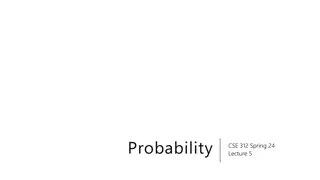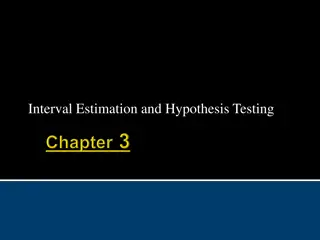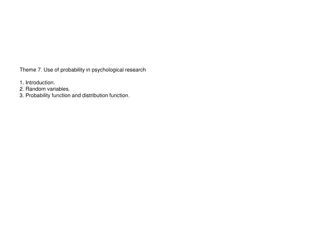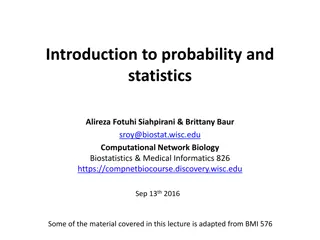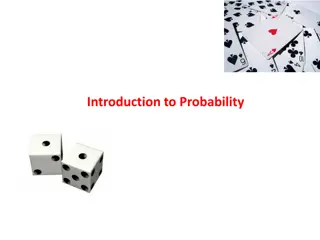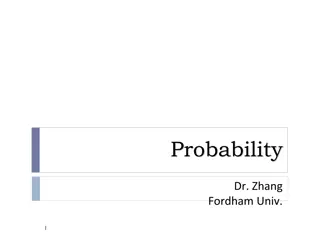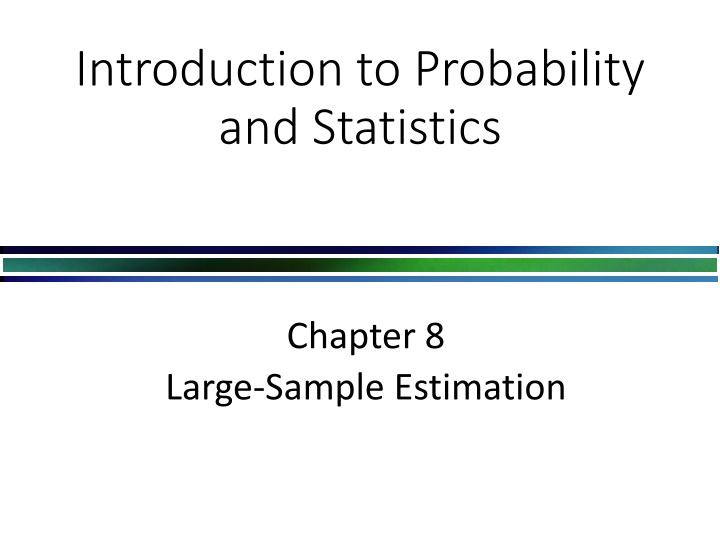
Large-Sample Estimation in Probability and Statistics
This chapter delves into large-sample estimation in the realm of probability and statistics. It covers populations, parameters, types of inference like estimation and hypothesis testing, examples of inference scenarios, definitions of estimators, and the concept of good point estimators. Explore how statistical methods aid in making inferences and determining the reliability of those inferences.
Download Presentation

Please find below an Image/Link to download the presentation.
The content on the website is provided AS IS for your information and personal use only. It may not be sold, licensed, or shared on other websites without obtaining consent from the author. If you encounter any issues during the download, it is possible that the publisher has removed the file from their server.
You are allowed to download the files provided on this website for personal or commercial use, subject to the condition that they are used lawfully. All files are the property of their respective owners.
The content on the website is provided AS IS for your information and personal use only. It may not be sold, licensed, or shared on other websites without obtaining consent from the author.
E N D
Presentation Transcript
Introduction to Probability and Statistics Chapter 8 Large-Sample Estimation
Introduction Introduction Populations and parameters For a normal population population mean m and s.d. s A binomial population population proportion p If parameters are unknown, we make inferences about them using sample information. Inferential Statistics
Types of Inference Types of Inference Estimation: Estimating the value of the parameter What is (are) the values of or p? Hypothesis Testing: Deciding about the value of a parameter based on some preconceived idea. Did the sample come from a population with = or p= .2?
Types of Inference Types of Inference Examples: A consumer wants to estimate the average price of similar homes in her city before putting her home on the market. Estimation: Estimate , the average home price. A manufacturer wants to know if a new type of steel is more resistant to high temperatures than an old type was. Hypothesis test: Is the new average resistance, equal to the old average resistance,
Types of Inference Types of Inference Whether estimating parameters or testing hypotheses, statistical methods of inferential statistics are to: Make statistical inference Tell goodness or reliability of the inference
Definitions Definitions An estimator is a rule, usually a formula, that tells you how to calculate the estimate based on the sample. Estimators are calculated from sample observations, hence they are statistics. Point estimation: A single number is calculated to estimate the parameter. Interval estimation: Two numbers are calculated to create an interval within which the parameter is expected to lie.
Good Point Estimators Good Point Estimators An estimator is unbiased if the mean of its sampling distribution equals the parameter of interest. It does not systematically overestimate or underestimate the target parameter. Sample mean is an unbiased estimator of population mean. Sample proportion is an unbiased estimator of population proportion. Sample variance is an unbiased estimator of population variance.
Good Point Estimators Good Point Estimators Of all the unbiased estimators, we prefer the estimator whose sampling distribution has the smallest spread or variability, i.e. smallest standard deviation or standard error.
Measuring the Goodness Measuring the Goodness of an Estimator of an Estimator The distance between an estimate and the true value of the parameter is the error of estimation. The distance between the bullet and the bull s-eye. In this chapter, the sample sizes are large, so that our estimators will have normal distributions. Because of the Central Limit Theorem.
The Margin of Error The Margin of Error For unbiasedestimators with normal sampling distributions, 95% of all point estimates will lie within 1.96 standard deviations of the parameter of interest. 95% Margin of Error: The maximum error of estimation, calculated as . 1 96 S of the estimator E
Estimating Means Estimating Means and Proportions and Proportions For a quantitative population, estimator Point of population mean : x s . 1 Margin of error ( 30 : ) 96 n n For a binomial population, = : Point estimator of population proportion p p x/n p q . 1 p q Margin of error ( , 5 : ) 5 96 n n n
Example Example A homeowner randomly samples 64 homes similar to her own and finds that the average selling price is $252,000 with a standard deviation of $15,000. Estimate the average selling price for all similar homes in the city. = Point estimator of : 252,000 s n x 15,000 64 = = Margin of error : 1.96 1.96 3675
Example Example A quality control technician wants to estimate the proportion of soda cans that are underfilled. He randomly samples 200 cans of soda and finds 10 underfilled cans. = = 200 estimator Point proportion of underfille cans d n p = = = p of : 10 / 200 05 . p x/n n (. 05 )(. 95 ) p q . 1 : = . 1 = 03 . Margin of error 96 96 200
Interval Estimation Interval Estimation Create an interval (a, b) so that you are fairly sure that the parameter lies between these two values. Confidence Interval Fairly sure means with high confidence , measured using the confidence coefficient, 1 Usually, 1- = Suppose 1- = .95 and that the estimator has a normal distribution. Parameter 1.96SE
Interval Estimation Interval Estimation Since we don t know the value of the parameter, consider which has a variable center. Estimator 1.96SE Worked Worked Worked Failed Only if the estimator falls in the tails will the interval fail to enclose the parameter. This happens only 5% of the time.
To Change the Confidence Level To Change the Confidence Level To change to a general confidence level, 1- , pick a value of z that puts area 1- in the center of the z distribution. z-value (??/2) 1.645 Tail area Middle Area (1- ) ) .05 .90 .025 .01 .005 1.96 2.33 2.58 .95 .98 .99 100(1- )% Confidence Interval: Estimator z SE
Confidence Intervals Confidence Intervals for Means and Proportions for Means and Proportions For a Quantitative Population Interval Confidence for Population a Mean : s x z / 2 n For a Binomial Population Confidence Interval for Population Proportion : p p q p z / 2 n
Example Example A random sample of n = 50 males showed a mean average daily intake of dairy products equal to 756 grams with a standard deviation of 35 grams. Find a 95% confidence interval for the population average 35 s . 1 7 56 96 . 1 7 56 . 9 70 96 x 50 n 746.30 or 65.70 7 grams.
Example Example Find a 99% confidence interval for the population average daily intake of dairy products for men. 35 s . 2 58 7 56 . 2 58 x 7 56 12 77 . 50 n 743.23 or 7 grams. 77 . 68 The interval must be wider to provide for the increased confidence that it does indeed enclose the true value of .
Example Example Of a random sample of n = 150 college students, 104 of the students said that they had played on a soccer team during their K-12 years. Estimate p, the proportion of college students who played soccer in their youth with a 98% confidence interval. p q 104 150 or . 69 (. 31 ) p . 2 33 . 2 33 n 150 78 . . 69 . 09 p .60 .
Estimating the Difference between Two Estimating the Difference between Two Means Means Sometimes we are interested in comparing the means of two populations. The average growth of plants fed using two different nutrients. The average scores for students taught with two different teaching methods. To make this comparison, drawn size of sample random A 1 sample random A from n 2 1 n population with 1 mean and variance of . 1 size drawn from 2 2 2 population with 2 mean and variance . 2
Estimating the Difference between Two Estimating the Difference between Two Means Means We compare the two averages by making inferences about - , the difference in the two population averages. If the two population averages are the same, then 1- = 0. The best estimate of 1- is the difference in the two sample means, x x 1 2
The Sampling Distribution of The Sampling Distribution of x x 1 2 The 1. mean of is 2 , the difference in x x 1 1 2 the population means. 2 1 2 2 = + The 2. standard deviation of is 2 SE . x x 1 n n 1 2 If . 3 the x sample x sizes are large, the sampling distributi on of approximat is 2 ely normal, and SE can estimated be 1 2 1 2 2 s s = + as SE . n n 1 2
Estimating Estimating 1 1- - For large samples, point estimates and their margin of error as well as confidence intervals are based on the standard normal (z) distribution. estimate Point for - : x x 1 2 1 2 2 1 2 2 s s + Margin of Error : 1.96 n n 1 2 Confidence Interval for - : 1 2 2 1 2 2 s s + ( ) x x z 1 2 / 2 n n 1 2
Example Example Avg Daily Intakes Sample size Sample mean Sample Std Dev Men 50 756 35 Women 50 762 30 Compare the average daily intake of dairy products of men and women using a 95% confidence interval. s n 2 35 (756 762) 1.96 50 2 1 2 2 s . 1 + ( ) 96 x x 1 2 n 1 2 2 30 50 6 12 78 . + or - 18.78 . 6 78 . 1 2
Example, continued Example, continued - 18.78 . 6 78 1 2 Could you conclude, based on this confidence interval, that there is a difference in the average daily intake of dairy products for men and women? The confidence interval contains the value 1- = 0. Therefore, it is possible that 1 = You would not want to conclude that there is a difference in average daily intake of dairy products for men and women.
Estimating the Difference between Two Estimating the Difference between Two Proportions Proportions Sometimes we are interested in comparing the proportion of successes in two binomial populations. The germination rates of untreated seeds and seeds treated with a fungicide. The proportion of male and female voters who favor a particular candidate for governor. To make this comparison, drawn size of sample random A 1 n from binomial population with 1 A parameter sample random . p of 1 size drawn from n 2 binomial population with 2 parameter . p 2
Estimating the Difference between Two Estimating the Difference between Two Proportions Proportions We compare the two proportions by making inferences about p -p , the difference in the two population proportions. If the two population proportions are the same, then p1-p = 0. The best estimate of p1-p is the difference in the two sample proportions, x x = p p 1 2 1 2 n n 1 2
The Sampling The Sampling Distribution of Distribution of p p 1 2 p The 1. mean of is 2 , the difference in p p p 1 1 2 the population proportion s. p q p q = + p The 2. standard deviation of is 2 SE . 1 n 1 2 n 2 p 1 1 2 If . 3 the p sample sizes are large, the sampling distributi on p of approximat is 2 ely normal, and SE can estimated be 1 p q p q = + as SE . 1 n 1 2 n 2 1 2
Estimating Estimating p p1 1- -p p For large samples, point estimates and their margin of error as well as confidence intervals are based on the standard normal (z) distribution. estimate Point : p for p -p p 1 2 1 p 2 q p q + Margin of Error : 1.96 1 n 1 2 n 2 1 2 Confidence interval for : p p 1 2 p q p q + ( p ) 1 n 1 2 n 2 p z 1 2 / 2 1 2
Example Example Youth Soccer Sample size Played soccer Male 80 65 Female 70 39 Compare the proportion of male and female college students who said that they had played on a soccer team during their K-12 years using a 99% confidence interval. p q p q + ( p ) . 2 58 1 n 1 2 n 2 p 1 2 1 2 65 39 81 . (. 19 ) 56 . (. 44 ) 2 . 5 19 . + ( ) . 2 58 80 or 70 80 . 70 .06 44 . p p 1 2
Example, continued Example, continued .06 44 . p p 1 2 Could you conclude, based on this confidence interval, that there is a difference in the proportion of male and female college students who said that they had playedon a soccer team during their K-12 years? The confidence interval does not contain the value p1-p = 0. Therefore, it is not likely that p1= p You would conclude that there is a difference in the proportions for males and females. A higher proportion of males than females played soccer in their youth.
Key Concepts Key Concepts I. Types of Estimators 1. Point estimator: a single number is calculated to estimate the population parameter. 2. Interval estimator: two numbers are calculated to form an interval that contains the parameter. II. Properties of Good Estimators 1. Unbiased: the average value of the estimator equals the parameter to be estimated. 2. Minimum variance: of all the unbiased estimators, the best estimator has a sampling distribution with the smallest standard error.
Key Concepts Key Concepts III. Large-Sample Point Estimators To estimate one of four population parameters when the sample sizes are large, use the following point estimators with the appropriate margins of error.
Key Concepts Key Concepts IV. Large-Sample Interval Estimators To estimate one of four population parameters when the sample sizes are large, use the following interval estimators.
Key Concepts Key Concepts 1. All values in the interval are possible values for the unknown population parameter. Any values outside the interval are unlikely to be the value of the unknown parameter. To compare two population means or proportions, look for the value 0 in the confidence interval. If 0 is in the interval, it is possible that the two population means or proportions are equal, and you should not declare a difference. If 0 is not in the interval, it is unlikely that the two means or proportions are equal, and you can confidently declare a difference. 2. 3.


